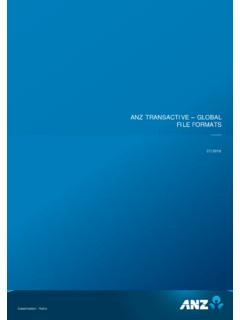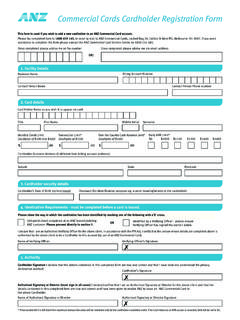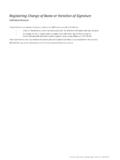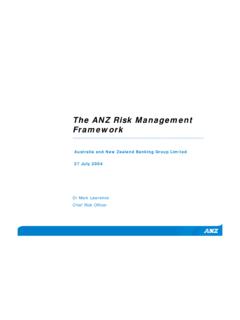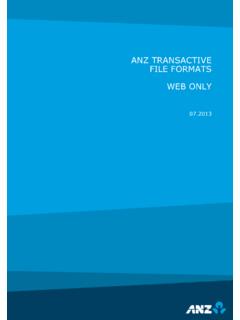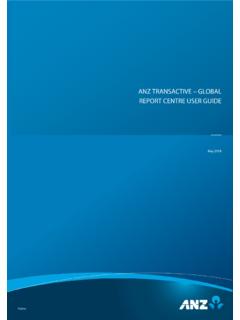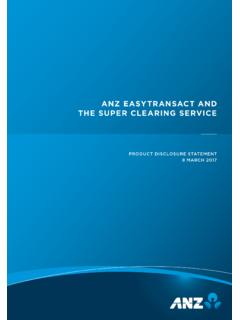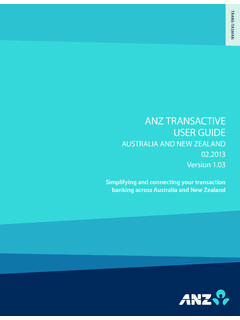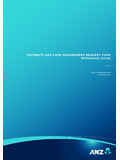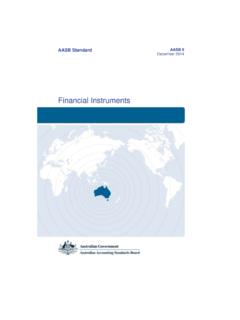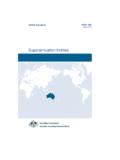Transcription of AASB 2 Impact on ANZ Reward
1 aasb 2 Impact on ANZ RewardShare based PaymentsOverview of changes ifrs 2 Share- based Payment was published by the International accounting standards board (IASB) in February 2004 and was adopted by the australian accounting standards board as aasb 2 AASB2 determines how share- based awards for reporting periods beginning on or after 1 January 2005 will be expensed The standard requires that the fair value of share awards and share options when they are granted be charged to the profit andloss account over the vesting period Under AGAAP, ANZ did not recognise an expense for options issued to staff and shares issued under the $1,000 employee share plan. However, deferred share issues were fully expensed up-front Performance Rights were not introduced at ANZ until October 2005 and will be recognised as an expense under aasb 2 Market vs Non-Market based ConditionsThe way plans are treated for the purposes of aasb 2 and how thefair value of an award is calculated, will depend on whether the performance conditions in the plan are market based or non-market BasedNon-Market based Market based performance conditions are conditions which are related to the company s share price, eg TSR ANZ determines the fair value at the start of the vesting period based on the probability of meeting the market condition* The final expense/P&L charge is notfurther adjusted to reflect the actual vesting of awards based on not meeting the market condition Non market based conditions are not related to share price performance (eg.)
2 Service conditions, EPS) ANZ initially estimates the number of shares that it expects to vest and accordingly adjusts the P&L charge The final charge to the P&L account is based on the actual number of shares which eventually vest and their original fair value Awards may be subject to both market and non-market based conditions. Eg ANZ hurdled options and Performance Rights are contingent on TSR hurdles andcontinued employment.*ANZ uses a Binomial option pricing model to assess the fair value of their options. This takes into account any performance hurdles and the non-transferability of the optionsExample Treatment of deferred shares AGAAPvsAASB 2 Under the ANZ deferred share plan, an entitlement to the shares is 'deferred' (held in trust on a participant s behalf) until a time in the future (usually 1 to 3years) and released based on continued service. No further performance conditions apply. Employee service is a non-market based : A grant of 5000 shares made at the beginning of year 1, to be held for 3 years The value for disclosing and expensing (1 day volume weighted average price) is $24 ANZ estimates that 20% of shares will be forfeited over the 3 year period due to employees leaving and forfeiting their shares .
3 ANZ revises this estimate during year 1 to 15% and further revises it during year 2 to 12%. At the end of year 3, 10% of shares have been forfeited under the scheme. the total number vesting is 4, 1$120,000 Year 2-Year 3-AGAAP:Under AGAAP, this expense was recognised upfront, P&L Charge$120,000 AIFRS - aasb 2:Under aasb 2, ANZ will prorate the expense over the vesting period and proposes to true up each year to reflect revised estimates of forfeitures and final number actually forfeited at the end of the period, 1 Year 2 Year 3 Total P&L ChargeTotal to be charged over period (5,000 x $24)$120,000$120,000$120,000"Trued up" for forfeitures$102,000$105,600$108,000 Multiplied by portion of vesting period expired1/32/33/3 Amount to be expensed up to this point$34,000$70,400$108,000 Minus what has already been charged$0$34,000$70,400 Amount expensed in year$34,000$36,400$37,600$108,000 Example Treatment of hurdled options under AGAAP vs aasb 2 Under the ANZ hurdled option plan, options are granted to participants subject to a relative TSR hurdle.
4 TSR is related to the share price so is categorisedas a market based condition. Awards are also contingent under most circumstances to continued : A grant of 5000 options made at the beginning of year 1, with a three year performance period/expected vesting period Scaled vesting applies with 50% vesting for median performance and 100% vesting for upper quartile performance The initial fair value calculated at date of grant, adjusted to take into account the performance condition is $ ANZ estimates that 20% of shares will be forfeited over the 3 year period due to employees leaving and forfeiting their shares . ANZ revises this estimate during year 1 to 15% and further revises it during year 2 to 12%. At the end of the year 3, 10% of shares have actually been forfeited under the scheme. the total number vesting is 4, :Under AGAAP, ANZ did not recognise options as an Treatment of hurdled options under AGAAP vsAASB 2 Under aasb 2, no matter what proportion of the award vests basedon the market condition, the P&L cost will reflect the initial fair value of the TSR condition as the possibility that the TSR hurdle may not be achieved has already been taken into accountwhen estimating the fair value at grant date.
5 ANZ will proratethe fair value of the TSR condition over the vesting period, and proposes to true up each year to reflect revised estimates for total forfeitures and the final number actually forfeited at the end of the period 2 Scenario 1:100% of award vests based on achievement of market based condition . Year 1 Year 2 Year 3 Total P&L ChargeTotal to be charged over period (5,000 x $3)$15,000$15,000$15,000"Trued up" for forfeitures$12,750$13,200$13,500 Multiplied by portion of vesting period expired1/32/33/3 Amount to be expensed up to this year$4,250$8,800$13,500 Minus what has already been charged$0$4,250$8,800 Amount expensed in year$4,250$4,550$4,700$13,500 aasb 2 Scenario 2:60% of award vests based on achievement of market based condition . Year 1 Year 2 Year 3 Total P&L ChargeTotal to be charged over period (5,000 x $3)$15,000$15,000$15,000"Trued up" for forfeitures$12,750$13,200$13,500 Multiplied by portion of vesting period expired1/32/33/3 Amount to be expensed up to this year$4,250$8,800$13,500 Minus what has already been charged$0$4,250$8,800 Amount expensed in year$4,250$4,550$4,700$13,500 Example Treatment of ANZ Performance Rights under AGAAPA Performance Right is a right to acquire a share at nil cost, subject to a holding period and relative TSR hurdle.
6 Upon exercise, each Performance Right entitles the holder to one ordinary ANZ share. Awards are also contingent under most circumstances to continued : A grant of 5000 Rights made at the beginning of year 1, with a three year performance period/expected vesting period Scaled vesting applies with 50% vesting for median performance and 100% vesting for upper quartile performance The initial fair value calculated at the date of grant, adjustedto take into account the performance condition is $ ANZ estimates that 20% of shares will be forfeited over the 3 year period due to employees leaving and forfeiting their shares . ANZ revises this estimate during year 1 to 15% and further revises it during year 2 to 12%. At the end of the year 3, 10% of shares have actually been forfeited under the scheme. the total number vesting is 4, :Performance Rights were not introduced at ANZ until October 2005, after the adoption of Treatment of ANZ Performance Rights under aasb 2 Similar to options, under aasb 2, no matter what proportion of the award vests based on the market condition, the P&L cost will reflect the initial fair value of the TSR condition, as the possibility that the TSR hurdle may not be achieved has already been taken into accountwhen estimating the fair value.
7 ANZ will prorate the fair value of the TSR condition over the vesting period, and proposesto true up each year to reflect revised estimates for total forfeitures over the period and the final number actually forfeited at the end of the period Scenario 1:90% of award vests based on achievement of market based condition. Year 1 Year 2 Year 3 Total P&L ChargeTotal to be charged over period (5,000 x $12)$60,000$60,000$60,000"Trued up" for forfeitures$51,000$52,800$54,000 Multiplied by portion of vesting period expired1/32/33/3 Amount to be expensed up to this year$17,000$35,200$54,000 Minus what has already been charged$0$17,000$35,200 Amount expensed in year$17,000$18,200$18,800$54,000 aasb 2 Scenario 2:0% of award vest as the market based condition is not achieved. Year 1 Year 2 Year 3 Total P&L ChargeTotal to be charged over period (5,000 x $12)$60,000$60,000$60,000"Trued up" for forfeitures$51,000$52,800$54,000 Multiplied by portion of vesting period expired1/32/33/3 Amount to be expensed up to this year$17,000$35,200$54,000 Minus what has already been charged$0$17,000$35,200 Amount expensed in year$17,000$18,200$18,800$54,000 The material in this presentation is general background information about the Bank s activities current at the date of the presentation.
8 It is information given in summary form and does not purport to be complete. It is not intended tobe relied upon as advice to investors or potential investors and does not take into account the investment objectives, financial situation or needs of any particular investor. These should be considered, with or without professional advice when deciding if an investment is further information contactStephen HigginsHead of Investor Relationsph: (613) 9273 4185 fax: (613) 9273 4091 e-mail.
